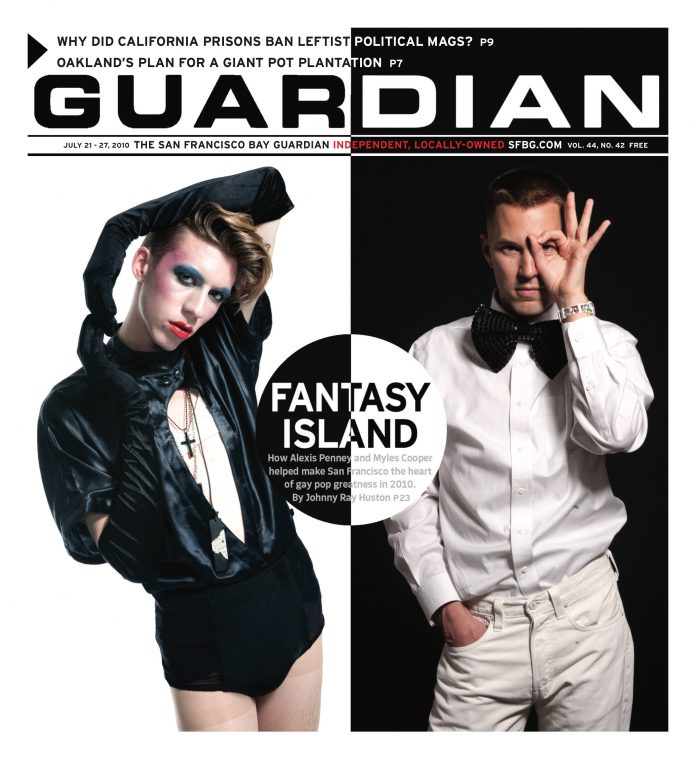news@sfbg.com
The centennial celebration of the Bay to Breakers race and party is once again being targeted for a crackdown on alcohol. But many participants say the problem is mismanagement more than booze or public urination.
Organizers this month announced that all racers and revelers in possession of alcohol will be cited and possibly detained by the San Francisco Police Department. Those pushing floats or, as event spokesperson Sam Singer put it, “alcohol delivery devices,” will be cited as well.
After hearing concerns from residents along the race route and losing corporate sponsor ING, executives from organizer AEG said its decision to curb excessive drinking is an attempt to save the venerable event.
“We received significant complaints from neighbors and residents about people peeing, puking, and passing out on their doorsteps who were not registered to race but were there to take advantage of the event and stage an open street party at expense of the community,” Singer told us. “Bay to Breakers will be 100 [years old] next year and, unless we take steps to ensure public safety, we are concerned for its future.”
Drawing more than 100,000 spectators and racers annually, Bay to Breakers is one of the largest races in the world. Even greater than its size is the reputation it has garnered as one of the city’s premier street parties, where revelers wear ridiculous costumes or sometimes nothing at all.
That reputation caused ING to pull out, announcing that it “evaluates its sponsorship programs and strategies to make sure they align with the goals of the business. The decision to not renew our sponsorship was based simply on ING’s shifting priorities.”
The company and others associated with the event last year tried unsuccessfully to ban kegs and glass bottles along with alcohol carried on floats. But opposition from participants and area Sup. Ross Mirkarimi saved the party.
Yet Singer said the outcome of the failed ban only strengthened organizers’ conviction to prohibit alcohol in subsequent years. “After the ban was put forward, a negotiation between people who are the party element took place and we ultimately allowed alcohol that year,” Singer said. “However, because alcohol was originally banned and the ban was later eased, the confusion contributed to having a safer experience. Most of the drinking element stayed away, which led us to realize we have to prohibit alcohol to keep a certain type of people away from the race.”
That “certain type of people” who seek to uphold the lenient alcohol precedent last year banded together to form Citizens for the Preservation of Bay to Breakers. CPBB cofounder Edward Sharpless said the group considers the ban a simplistic distraction from AEG’s gross mismanagement of an event whose biggest problems could be easily mitigated.
“They have no respect for the event and no interest in preserving the San Francisco tradition of Bay to Breakers,” Sharpless said. “They have failed to provide an adequate amount of Porta Potties or set up appropriate barriers. It has nothing to do with booze or floats. They are merely trying to mask their incompetence by pointing the finger yet again.”
According to the race website, AEG provided only 705 portable toilets last year. Although that number may be sufficient for the 30,000 racers, it proved too few for the more than 100,000-person event. Even Mayor Gavin Newsom last year ran in the event without registering, he told the San Francisco Chronicle.
“They just aren’t addressing issues,” Sharpless said. “Their mind-set has been to support only the 30,000 registered runners, and once those people have gone by it’s everyone else’s problem. It doesn’t work like that.”
Wayne Lanier, a resident at 256 Ashbury St., last year tried to stop a young man from urinating in his yard, informing him that he would take a photograph and notify the police. “He responded with, ‘I don’t care, I’m from L.A.,'<0x2009>” Lanier told us. “They had an attitude that expressed their right to party and who were we to question it. It was just unbelievable.”
Sharpless said he wants to heed residents’ complaints. “The management is supposed to be professional, so something like public urination and a little bit of public drunkenness should be dealt with,” Sharpless said. “The priority is the neighbors, their private property, and their well-being. Just sticking your head in sand and turning a blind eye to the problem is not a solution.”
Sharpless and others met with officials in the Mayor’s Office July 12, seeking a dialogue between community groups, residents, city officials. and AEG. Some press coverage framed the meeting as simply about drunkenness, but Sharpless said mismanagement of the event was a key topic.
“The meeting was scheduled two weeks ago, before AEG decided to announce the ban,” Sharpless said. “The reason Sam announced the ban subsequently is because he wanted to make it look like it was about a ban on alcohol when really it was a focus group on neighborhood damage.”
AEG is expected to present a plan for next year’s event toward the end of summer. “We will be working with the police department on having a larger and more strategically placed police force to help ensure safety,” Singer said. “We are also planning on doing extensive outreach and advertising to inform the public of this year’s new rules.”
Sharpless remains confident that the party will go on. “It looks like we have a good, constructive start,” he said. “Of course we don’t support the alcohol ban. This isn’t just a 12K race. This is Bay to Breakers. This is a civic institution that represents the uniqueness of San Francisco, and we will fight to save it.”

